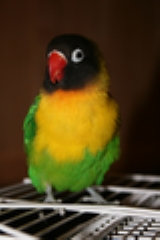
Masked Lovebird
Encyclopedia
The Yellow-collared Lovebird (Agapornis personatus), also called Masked Lovebird or Eye Ring Lovebird, is a monotypic species of bird
of the lovebird
genus in the parrot
family. They are native to northeast Tanzania
, and they have been introduced to Burundi and Kenya.
_-auckland_zoo.jpg) The blue mutation was originally found in wild birds in the 1920s and is the oldest colour mutation known in the lovebird genus. The other mutations are a result of selective breeding in aviculture, such as two cobalts which will make a mauve (black). Various color mutations exist, including blue, cobalt, mauve, slate, dilute slate, violet, lutino (ino) and albino. The latter two are mutations where some color genes do not get passed on from the previous generation. In the case of the lutino the green color gene is not passed on. In the case of the albino, none of the color genes are passed on. The albino mutation is the last color mutation.
The blue mutation was originally found in wild birds in the 1920s and is the oldest colour mutation known in the lovebird genus. The other mutations are a result of selective breeding in aviculture, such as two cobalts which will make a mauve (black). Various color mutations exist, including blue, cobalt, mauve, slate, dilute slate, violet, lutino (ino) and albino. The latter two are mutations where some color genes do not get passed on from the previous generation. In the case of the lutino the green color gene is not passed on. In the case of the albino, none of the color genes are passed on. The albino mutation is the last color mutation.
White eye-rings lovebirds, of which black-masked is part of, are also more aggressive in comparison to the Peach-faced Lovebird. Lovebirds usually cost $50 upwards, depending on color mutations, in US stores. Hand-fed birds will command a premium due to their tame nature towards humans.
Bird
Birds are feathered, winged, bipedal, endothermic , egg-laying, vertebrate animals. Around 10,000 living species and 188 families makes them the most speciose class of tetrapod vertebrates. They inhabit ecosystems across the globe, from the Arctic to the Antarctic. Extant birds range in size from...
of the lovebird
Lovebird
A Lovebird is one of nine species of the genus Agapornis . They are a social and affectionate small parrot. Eight species are native to the African continent, while the Grey-headed Lovebird is native to Madagascar...
genus in the parrot
True parrots
The true parrots are about 330 species of bird belonging to the Psittacidae family, one of the two "traditional" families in the biological order Psittaciformes . The other family is the Cacatuidae which are also parrots, but not classified as true parrots...
family. They are native to northeast Tanzania
Tanzania
The United Republic of Tanzania is a country in East Africa bordered by Kenya and Uganda to the north, Rwanda, Burundi, and the Democratic Republic of the Congo to the west, and Zambia, Malawi, and Mozambique to the south. The country's eastern borders lie on the Indian Ocean.Tanzania is a state...
, and they have been introduced to Burundi and Kenya.
Description
The Yellow-collared Lovebird is a mainly green small parrot about 14.5 cm (5.5 in) long. Its upper parts are a darker green than its lower surfaces. Its head is black, and it has a bright red beak and white eyerings. Yellow on the breast is continuous with a yellow collar and an expansion of yellow over the nape of the neck. Male and female have identical external appearance.Breeding
The Yellow-collared Lovebird brings nesting material in its beak to a tree cavity for their nest. The eggs are white and there are usually four to five in a clutch. The female incubates the eggs for about 23 days and the chicks leave the nest about 42 days after hatching.Aviculture
_-auckland_zoo.jpg)
White eye-rings lovebirds, of which black-masked is part of, are also more aggressive in comparison to the Peach-faced Lovebird. Lovebirds usually cost $50 upwards, depending on color mutations, in US stores. Hand-fed birds will command a premium due to their tame nature towards humans.

